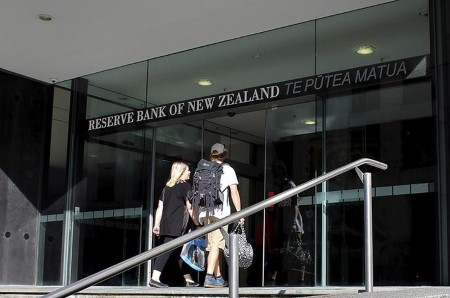- RBNZ keeps interest rates steady at 1.75 percent
- RBNZ still expects inflation to pick up gradually
- RBNZ says lower NZ dollar would help rebalance growth
- Foils expectations for a more dovish tone
(Updates throughout)
The Reserve Bank of New Zealand stuck firmly to its neutral stance on Thursday, saying there was no need to cut rates given a likely pick-up in inflation and appeared to be less worried about the country's strong currency than some expected.
RBNZ Governor Graeme Wheeler said on Thursday that monetary policy would remain accommodative for a while yet, sticking to the language of recent statements after keeping interest rates at a record-low 1.75 percent - as expected.
The central bank said capacity pressures would gradually push non-tradables inflation higher and reiterated the risk of house prices rising again.
"We're still very much in the neutral stage where for the foreseeable future we don't see the OCR (official cash rate) increasing," said Wheeler, addressing his last monetary policy news conference before his five-year term ends next month.
He stressed, however, that neither was there any need to reduce interest rates after keeping them at a record low for the fifth consecutive policy review.
"At the moment we don't feel that (a cut) is needed in order to get inflation back to the mid-point over time," he said referring to the middle of the 1-3 percent inflation target.
The RBNZ also said it favoured a lower New Zealand dollar, although it avoided bold language, prompting a brief jump in the local currency. It later noted the central bank had the capability to intervene in the foreign exchange market, although historically the RBNZ has been very reluctant to do so.
The RBNZ said in the statement that the trade-weighted exchange rate had risen since the last monetary policy statement in May partly in response to a weaker U.S. dollar and said that a lower dollar would help increase tradables inflation and achieve more balanced growth.
The dollar jumped to $0.7371 but pared back some of those gains. It is up nearly 6 percent this year.
"One thing that's contrary to market expectations is that they weren't very forceful on the language around the exchange rate," said Ben Jarman, economist at JP Morgan in Sydney.
"In the current environment, if a central bank is not very upset about currency appreciation, it's a green light to go further."
GROWTH OUTLOOK All 21 economists in a Reuters poll expected the central bank to stay put on Thursday, but some had expected it to strike a more dovish tone by acknowledging the recent run of softer data or adjusting its inflation and interest rate forecasts.
After posting some of the fastest growth among advanced economies in recent years, there are tentative signs the economy is losing momentum: it grew less than expected in the first quarter, inflation slowed more than forecast in the second quarter, and employment unexpectedly contracted.
Despite this, the central bank sees inflation growth slowing this year by more than forecast in the May statement, although it expects inflation to reach 2.0 percent in the first quarter of 2020 - broadly in line with forecasts in the May statement.
The bank made no changes to its official cash rate forecasts, which project rates will rise in early 2020.
The central bank expected growth to speed up, supported by low interest rates, strong population growth and fiscal stimulus in the 2017 budget.
"We were expecting a little bit more dovishness within the statement, but clearly it shows that it's not going to take one or two data points to shift the RBNZ," said Philip Borkin, senior economist at ANZ.
"They're very much in neutral and the hurdle for action in either direction is pretty high."
- Forums
- NZX - General
- News: UPDATE 2-RBNZ less dovish on rates than expected, favours lower NZ$






